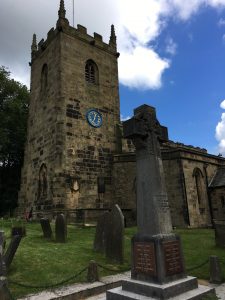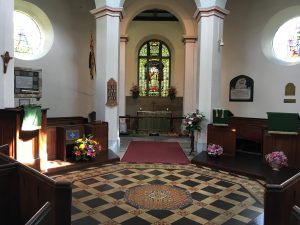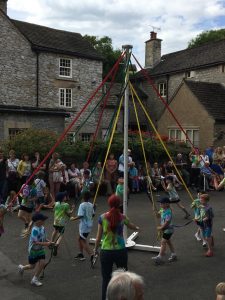I failed to post yesterday because I didn’t really do anything worth noting. My hosts had a funeral to attend and it was raining pretty much all day, so I did some reading and relaxed at Lees Farm. In the afternoon Keith and Lynn taught me how to play Mah Jong, which is more complicated and takes more brain cells to play well than I had realized. Then we headed out to see the new film “Dunkirk” with their daughter and her fiancé. The film was quite good I thought; depicted the horrors of war and indiviual struggles to survive and do one’s duty.
Today there was some sun for part of the day, so we headed out to see some villages in Derbyshire. The landscape along the way was stunning — lovely green hills and dales, dry stone walls and dotted with sheep and cows. Our first stop was Eyam, the Plague Village. The story goes that the local tailor had ordered some cloth from London where the Bubonic Plague was raging in 1665. The fabric held hidden in it some infected fleas which began the cycle of flea to rat to flea to human and by the beginning of the following summer, with scores of dead, the local vicars persuaded the village to quarantine itself in order to prevent the spread to other townships in Derbyshire. There were boundaries declared and people from other towns would bring food to leave at these boundaries, and accept the money doused in vinegar in return. In this way Eyam did not starve. Whole families were killed off; Elizabeth Hancock buried her husband and 6 children in on plot on her farm which still stands. The plague lasted about 16 months in the village, and took the lives of about half of the population — 180 people — but it did contain the spread of it. The church has a section from Norman times, a stained glass window called the Plague Window, a font from the 9th C, and a Celtic cross from the 8th C, and a sundial dating from 1775.
Here’s a tidbit — the original children’s rhyme goes like this:
“Ring a ring of roses a pocket full of posies atishoo atishoo we all fall down”. The roses refer to the purple patches that developed on the chest of victims of the plague; posies were likely the noegays of herbs carried to ward off the disease; sneezing was a symptom, and there was no known cure. Interesting how in the U.S. we have modified the rhyme to essentially be meaningless.
From Eyam we drove to Stoney Middleton, which was one of the villages that provided the people of Eyam with food during their quarantine. On the way there’s a view of some great limestone ledges; one in town is called Lover’s Leap for the woman who jumped, but lived to tell of her unrequited love. This village was settled as early at 1086, and may have based on the nearby lead mining. We went today for the annual “Well Dressing”, which date to 1935. It is a form of Thanksgiving for abundant water and three wells are “dressed”; a well dressing are pictorials made up of flowers, petals, seeds, leaves, moss, bark and other natural products set in clay. They require weeks of works by the community. The craftmanship reminded me of that of the floats in the Rose Parade, on a smaller scale. There was a local band which played, and the wells were blessed in a short service by the Vicar, followed by the children dancing around the Maypole and some fun and games for the the families gathered.
St Martin’s Church is of note. The tower is all that remains of the original 15th C church which was built by a local woman in thanks for the safe return of her bethrothed from Agincourt. The nave is unusual because of it’s octagonal shape based on the Palladian Rotunda style. It was built in 1759.
On the way back to Leek the clouds rolled in, providing a stark contrast to the green rolling hills — quite striking.
And that was Friday and Saturday.



















Lorrie…a beautiful part of England. Spent a week at a friend’s footage there
Many years ago and took a long walk through the countryside with friends….finally walked through Eyam, which I found fascinating…and very very sad.
It was my first time in the north and I found it simply stunning too. I’m so glad you’re following along on my journey!
The “posies” / nosegays also were used to cover the stench of death and decay.